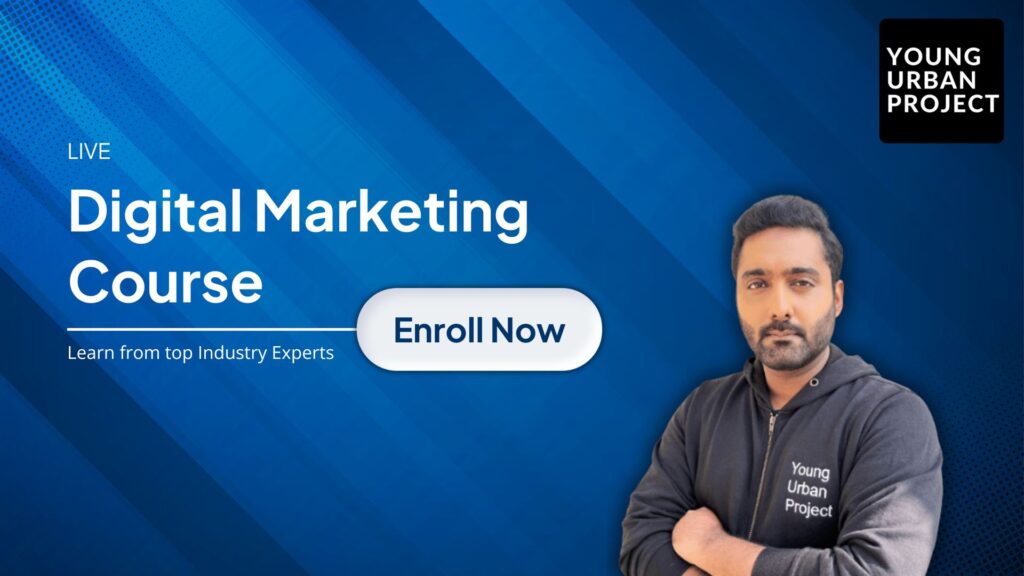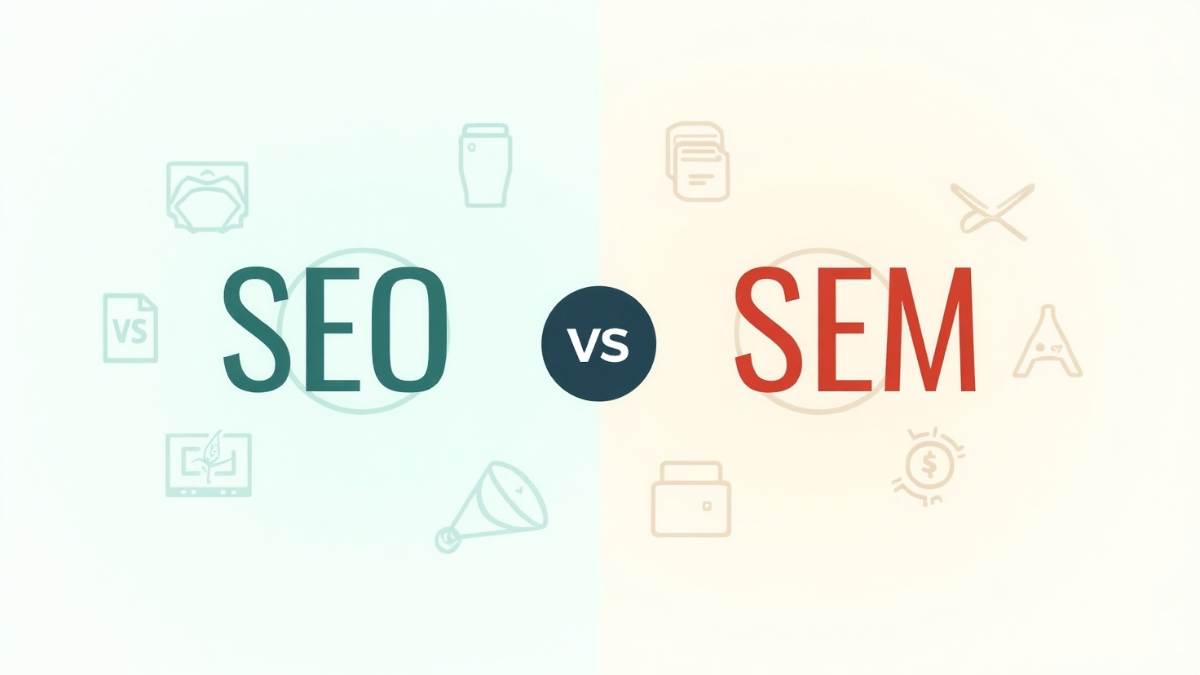If you’ve ever tried to market your business online, chances are you’ve come across the terms SEO and SEM. They sound similar. They even overlap in some ways. But they’re not the same. And knowing the difference can save you time, money, and a lot of frustration.
Let’s break the main Difference Between SEO and SEM down properly – no jargon, no vague advice – so you can walk away knowing exactly which one makes sense for your business.
Table of Contents
What is SEO (Search Engine Optimization)?
SEO stands for Search Engine Optimization. In simple words, it’s the process of improving your website so that search engines like Google show it to people when they’re searching for something.
The best part about SEO? When you rank well on Google, the clicks you get are free. You don’t have to pay Google every time someone visits your site through those organic results.
But SEO takes effort, and it’s not something you can turn on or off instantly.
3 Main Types of SEO:
These are the 3 main types of SEO:
1. On-Page SEO
Optimizing what’s on your website:
- Keywords
- Headings
- Meta descriptions
- Images (with ALT text)
2. Off-Page SEO
Building your site’s reputation by:
- Getting backlinks from other websites
- Brand mentions
- Social media engagement (indirectly helps)
3. Technical SEO
Making sure your site is:
- Fast to load
- Mobile-friendly
- Easy for Google to “crawl” and understand
Example of SEO in Action:
Imagine you sell running shoes online. You write a detailed blog post: “Best Running Shoes for Beginners”. With proper SEO, that blog can show up on page 1 when people search for that exact topic.
The clicks you get from that are organic traffic – meaning you didn’t pay for each visit.
Also Read: What are Zero-Click Searches in SEO
What is SEM (Search Engine Marketing)?
Now, SEM is like SEO’s more impatient sibling.
SEM stands for Search Engine Marketing. It’s the umbrella term for paid strategies to appear in search engine results.
If you’ve seen Google search results with the word “Ad” next to them at the top, that’s SEM in action.
What Does SEM Include?
- PPC (Pay-Per-Click Ads) – You pay every time someone clicks your ad.
- Display Ads – Banner or image ads across Google’s partner websites.
- Shopping Ads – Product images and prices that show up on Google Shopping.
Where Does SEM Run?
- Google Ads (formerly AdWords) – The biggest platform.
- Bing Ads – Less traffic, often cheaper clicks.
- Amazon Ads – Huge for eCommerce sellers.
Example of SEM in Action:
Let’s go back to that running shoes example. You can pay to appear right at the top of Google when someone searches “best running shoes for beginners.” You’ll pay a fee every time someone clicks on your ad. That’s SEM.
Difference Between SEO and SEM
Let’s get real about how they compare:
| Factor | SEO (Search Engine Optimization) | SEM (Search Engine Marketing) |
| Meaning | Process of optimizing your website to appear in organic (unpaid) search results. | Running paid advertisements to appear in search engine results. |
| Type of Traffic | Organic traffic – Free clicks generated through search rankings. | Paid traffic – Clicks that are charged on a per-click or impression basis. |
| Cost Model | No direct payment for clicks. Investment goes into content creation, SEO tools, and possible agency/freelancer costs. | Pay-Per-Click (PPC) or Cost-Per-Thousand-Impressions (CPM). Pay for every visitor who clicks the ad. |
| Time to Get Results | Slow. Usually takes 3 to 6 months (or more) to see meaningful results, depending on competition. | Immediate. Results start as soon as the ad campaign is live. |
| Longevity of Results | Long-term. Once ranked, pages can bring traffic for months or years without further cost (if maintained). | Short-term. Traffic stops as soon as the ad budget is exhausted. |
| Click-Through Rate (CTR) | Often higher for organic results, especially if ranking in the top 3 positions. | Can be lower than organic, as some users skip ads. Depends heavily on ad copy quality and targeting. |
| Trust Factor | Generally seen as more trustworthy by users, as results are earned based on relevance and authority. | Often viewed with skepticism by users since ads are marked and clearly paid for. |
| Control Over Placement | Limited control. Rankings depend on Google’s algorithm, backlinks, content quality, and competition. | Complete control. You can bid for keywords, choose placements, and adjust budgets anytime. |
| Targeting Options | Limited mainly to content relevance and keyword optimization. Geographic targeting possible via Google My Business. | Highly flexible. Target by location, device, demographic, interests, time of day, remarketing lists, and more. |
| Conversion Speed | Slower funnel. People might first visit for information and convert later. | Faster funnel. Ads target people ready to take immediate action (e.g., buy, sign up). |
| Ideal For | Brand building, long-term authority, lead nurturing, informational content, evergreen traffic. | Promotions, product launches, time-sensitive offers, generating fast leads or sales. |
| Scalability | Gradual scaling. Growth depends on content production, backlink acquisition, and algorithm updates. | Instantly scalable. Increase budget → get more impressions/clicks almost immediately. |
| Sustainability | Sustainable long-term if maintained with regular content updates and optimization. | Unsustainable without budget. As soon as you stop paying → traffic drops to zero. |
| Learning Curve | Requires knowledge of SEO fundamentals, algorithms, and technical aspects. | Requires skills in PPC setup, keyword bidding, ad copywriting, and analytics. |
| Data & Analytics | Metrics available through Google Analytics & Search Console: traffic, impressions, CTR, etc. | More granular metrics via Google Ads: impressions, CTR, CPC, conversion rates, ROAS (Return on Ad Spend). |
| Example Scenario | Ranking a blog post for “best eco-friendly running shoes” to build authority and capture early research-stage users. | Running a Google Ad for “buy eco-friendly running shoes online” targeting users ready to purchase. |
| Dependency | Depends on Google’s algorithm updates, competition level, and site authority. | Depends on ad budget, bid competitiveness, and ad relevance. |
| Use with Other Channels | SEO complements content marketing, email marketing, and social media for holistic inbound strategies. | SEM works well alongside remarketing ads, sales funnels, and outbound paid media strategies. |

Enroll Now: Advanced Digital Marketing Course
SEO vs SEM: Which One Should You Use?
This isn’t about which is better overall – it’s about what’s better for you right now.
1. When SEO Makes More Sense:
- You want long-term results without constant ad spend.
- Your focus is on becoming an authority in your niche.
- You want consistent, steady traffic over time.
Also Read: Best AI SEO Tools to Boost Rankings
2. When SEM Makes More Sense:
- You’ve just launched and need immediate traffic.
- You’re running a limited-time promotion.
- You need to target high-buying-intent keywords.
3. When to Use Both Together:
- You want to completely dominate search results (appearing both in ads and organically).
- You’re running a product launch campaign, but also want SEO blogs ranking over time.
- You want full control: short-term wins with SEM, long-term authority with SEO.
Costs: SEO vs SEM – What Should You Expect to Spend?
Here’s what most people don’t tell you:
- SEO isn’t free.
Even though you’re not paying for each click, you’ll likely invest in:
→ Tools (like Ahrefs, SEMrush, or Surfer SEO)
→ Content writing (if you’re not doing it yourself)
→ SEO agencies or freelancers
- SEM costs vary wildly.
→ Google Ads CPC can range from ₹5 per click to ₹500+, depending on competition.
→ Competitive niches like finance or insurance can go even higher.
Example:
- SEO blog may take 3 months to rank and cost ₹10,000–₹30,000 (writing + SEO help).
- SEM ad can run instantly with ₹5,000, but stops the moment you stop paying.
How Long Does It Take to See Results?
| SEO | SEM |
| 3-6 months (minimum) | Instant (as soon as ad is approved) |
| Needs patience | Works like a tap – you turn it on/off |
| Lasting results | Temporary unless consistently funded |
If you need results yesterday, go SEM. If you’re planning for next quarter, work on SEO now.
Top Tools to Help You Succeed
For SEO:
- Google Search Console (Free) – Must-have.
- Ahrefs / SEMrush (Paid) – Track keywords, find backlinks.
- Yoast SEO (For WordPress Users) – Optimize pages and posts easily.
For SEM:
- Google Ads Platform – Set up, manage, and track campaigns.
- Google Keyword Planner – Great for keyword research.
- Semrush PPC Toolkit – Spy on competitors’ ads and manage campaigns.
Also Read: The Difference Between On-Page and Off-Page SEO
Common Mistakes to Avoid
SEO Mistakes:
- Writing only for search engines, not people.
- Ignoring technical SEO (site speed, mobile issues).
- Forgetting to optimize existing pages, not just new ones.
SEM Mistakes:
- Sending ad traffic to a bad landing page.
- Using broad match keywords without negative keywords (wastes budget).
- Ignoring conversion tracking – never run ads blind.
How SEO and SEM Can Work Together
Pro tip? Don’t think of SEO and SEM as enemies. Use them together for full effect:
- Use PPC data → Learn which keywords convert → Use those in your SEO strategy.
- Retargeting → Someone visits your SEO blog → Show them a paid ad later → Higher chance of sale.
- Dominate Search Results → Your paid ad on top + your blog ranking below = Maximum visibility.
Also Read: SEO vs Performance Marketing
Conclusion
Look, here’s the deal with SEO and SEM – they’re both necessary, just at different times. SEO takes forever but pays off big time once it kicks in. SEM gets you traffic today but costs money every single day.
Most successful businesses don’t pick sides. They start with one based on their immediate needs and budget, then gradually add the other. If you’re strapped for cash, go SEO first. Need sales this month? SEM is your friend.
The real winner? Using data to decide what works for YOUR business. Track everything, test different approaches, and don’t get stuck in the “either-or” mindset. Your competitors are probably doing both.
FAQs
Is SEO better than SEM for long-term results?
SEO wins long-term hands down. Once you rank, that traffic keeps coming without paying for each click. SEM stops the moment you stop paying.
Can I do SEO and SEM at the same time?
Absolutely. Smart businesses use both – SEO builds the foundation while SEM fills gaps and targets specific campaigns. They actually help each other.
Which is cheaper: SEO or SEM?
SEO costs time and maybe tools, but no ad spend. SEM costs real money daily. SEO is cheaper long-term, SEM is predictable short-term.
How long does it take to see results from SEO?
Expect 3-6 months minimum for real results. Competitive niches take longer. Anyone promising SEO results in 30 days is lying to you.
Is SEM only about Google Ads?
Nope. SEM includes Bing Ads, Amazon advertising, social media ads, and any paid search platform. Google just gets most of the attention.
Which works better for eCommerce businesses?
Both, honestly. SEM for product launches and sales, SEO for building brand authority. Most successful online stores use both strategically.

